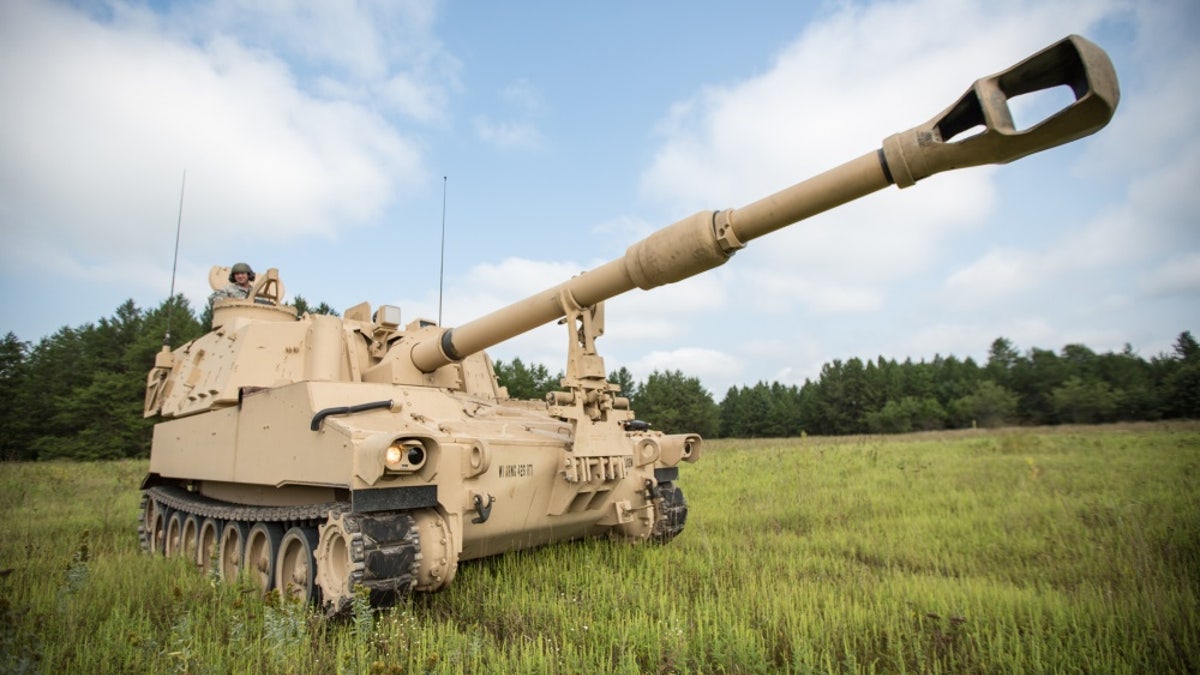
U.S. Army Wisconsin National Guard Soldiers from the 1-426 Field Artillery Battery operate an M109A6 Paladin Howitzer at Fort McCoy, Wis., August 18, 2018. (Photo by Spc. John Russell/U.S. Army)
The Army is starting formal production of a new Self-Propelled Howitzer variant engineered for faster movement, better structural protection, improved drive-train ability, new suspension and advanced networking tech, service and industry developers said.
The new vehicle is built with a more capable, larger chassis, designed as an initial step toward building a next-generation cannon able to outgun existing Russian weapons.
As part of a longer-term plan to leverage the new larger chassis built into the Army’s new M109A7 variant, the Army’s Armament Research, Development and Engineering Center is beginning work on a new cannon able to hit enemies out to 70 kilometers (43.5 miles), senior Army developers said.
Senior Army weapons developers have explained that the current 80s-era 39 calibre Howitzer is outgunned by its Russian equivalent - a scenario the service plans to change.
A 70-kilometer target range is, by any estimation, a substantial leap forward for artillery; when GPS guided precision 155mm artillery rounds, such as Excalibur, burst into land combat about ten years ago - its strike range was reported at roughly 30 kilometers. A self-propelled Howitzer able to hit 70-kilometers puts the weapon on par with some of the Army’s advanced land-based rockets - such as its precision-enabled Guided Multiple Launch Rocket System, which also reaches 70-kilometers.
In a modern threat environment, wherein near-peer and smaller-level rivals increasingly possess precision-guided land weapons, longer-range C4ISR technology and drone weapons, increasing range is a ubiquitous emphasis across the Army and other services. Russia’s violations of the INF treaty, new S-500 air defenses, new Armata tanks and fast growing attack drone fleet - all point to a growing need for the US to outrange and outgun potential adversaries.
Furthermore, given the Pentagon’s emphasis upon cross-domain warfare, land weapons are increasingly being developed to attack things like enemy ships, aircraft and ground-based air defenses; naturally, the idea is to pinpoint and destroy enemy targets while remaining at a safer, more protected distance.
Former Deputy Program Executive Officer for Missiles & Space, Brig. Gen. Robert Rasch (Rasch is now the PEO) told Warrior in a previous interview that the service is making a decided push to upgrade and develop longer-range weapons as a way to address current threats - and re-adjust following more than 15 years of counterinsurgency.
Building a Higher-Tech, More Lethal Paladin
Following years of development and advanced engineering, the Army and BAE Systems are now formally entering full-rate production of the new M109A7 and accompanying M992A3 ammunition carrier vehicles. BAE officials said the new Howitzer, designed to replace the existing M109A6 Paladin, will have 600-volts of on-board power generation, high-voltage electric gun drives and projectile ramming systems.
Army developers say the A7 has a turret ring down revamp, including a new hull along with a new suspension and power-train. The new Howitzer will, among other things, greatly improve speed and mobility compared to the A6.
“In the past, the A6 Paladin was the slowest vehicle in the Army. It needs to leapfrog. We are restoring that mobility so it will be one of the faster vehicles. Howitzers can now outrun 113s," a senior Army weapons developer said.
Also, as part of maintenance, life-cycle and service extension - all aimed to improve logistics - the new Howitzer is built with an engine and other parts common to the Bradley Fighting Vehicle and emerging Armored Multi-Purpose Vehicle.
Improved on-board power is, similar to other emerging higher-tech platforms, designed to enable the vehicle to quickly accommodate upgrades and new weapons technologies as they may evolve - such as lasers or advanced ammunition.
The advanced digital backbone and power generation capability provides significant growth potential for future payloads, a BAE Systems statement said.
One senior Army official told Warrior Maven that improved combat connectivity can enable multiple Howitzers to quickly share firing data, as part of a broader effort to expand battlefield networking and operate in more dispersed formations depending upon mission requirements.
The Army has also been working with the Pentagon’s Strategic Capabilities Office to explore additional innovations for the Howitzer platform.
While initially conceived of and developed for the Navy's emerging Rail Gun Weapon, the Pentagon and Army are now firing the Hyper Velocity Projectile from an Army Howitzer in order to potential harness near-term weapons ability, increase the scope, lethality and range ability to accelerate combat deployment of the lethal, high-speed round.
The rail gun uses an electromagnetic current to fire a kinetic energy warhead up to 100 miles at speeds greater than 5,000 miles an hour, a speed at least three times as fast as existing weapons.
--- To Read Warrior Maven's Previous Report on Howitzers Firing the Rail Gun Round, CLICK HERE ---
Firing from an Army Howitzer, the hypervelocity projectile can fire at high speeds toward enemy targets to include buildings, force concentrations, weapons systems, drones, aircraft, vehicle bunkers and even incoming enemy missiles and artillery rounds.
"We can defend against an incoming salvo with a bullet," a senior Pentagon weapons developer told reporters during prior testing of the HVP.
More Weapons and Technology - WARRIOR MAVEN (CLICK HERE)--




















